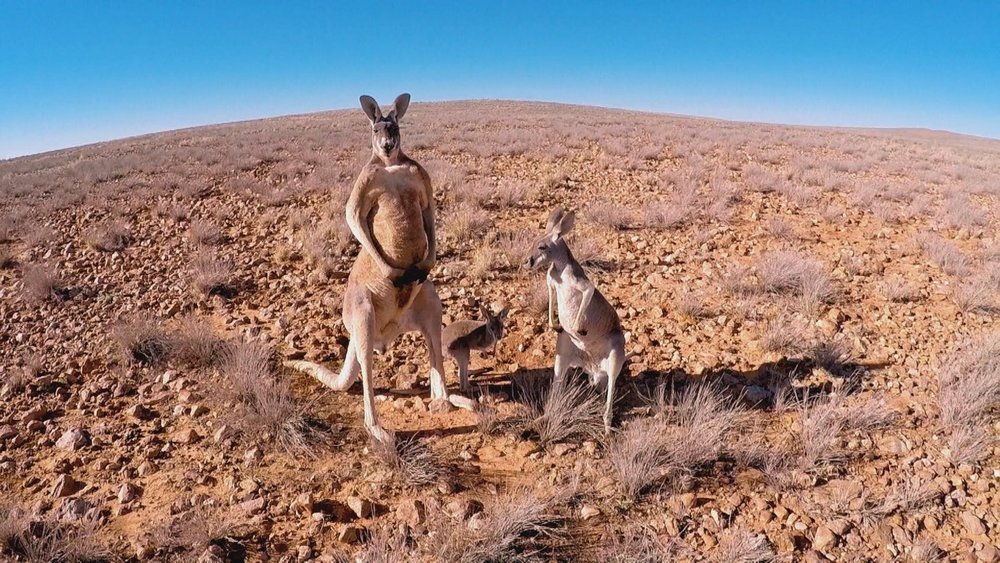The old myth of riding a kangaroo to school is shot dead in the dark of the night in the opening moments of Kangaroo: A Love-Hate Story. Said kangaroo springs into the air as the bullet pierces its neck, the pain clearly evident as it flees into the dark petrified. Unlike the seals of Canada, this slaughter occurs at night, when the roos are most active and the public can’t see a thing. They don’t scream out in pain, instead suffering in silence, the palpable fear clearly evident in their eyes.
This is not an easy sit. That shot kangaroo bounds off into the darkness in fear to either die a long, drawn out death, or to be hunted down and finished off like they’re nothing. The person behind the camera that’s capturing the footage of the kangaroos being slaughtered voices their alarm that this is happening on their property again. As an opening to a film, there’s no bigger slap in the face to ensure you’re going to pay attention to what will unfurl over the next hour and forty five minutes than here.
Kangaroo is a searing, unrelenting, devastating documentary that looks at the way Australia treats its national icon. It makes up one half of the Australian emblem. It stands proudly atop the Australian parliament in Canberra. It flies across the world on the tail of QANTAS planes. Yet, it’s long been considered a pest, a source of irritation for Aussie farmers. There’s admiration and adoration for this unique marsupial, yet equally, there is disgust and hatred directed towards them for simply existing.
Directors Kate McIntyre Clere and Michael McIntyre have crafted Australia’s answer to The Cove and Blackfish. This is not to say that there isn’t a bid to try and have a fair and balanced discussion about kangaroos in Australia, with farmers who are affected by kangaroos being given a fair amount of time to discuss exactly why they want kangaroos eliminated from their property (as well as neighbouring properties too). However, their discussions, when presented alongside the clear evidence of brutality directed towards kangaroos, feels more like they’re talking from an era long gone.
ABC News footage from the 60’s and 70’s is presented to give an understanding of how the perception of kangaroos has changed over the years (spoiler alert: it hasn’t changed a heck of a lot). The impact of colonialism on Australian wildlife is giving a thorough assessment with the British penchant for hunting shown in all its terrifying glory. Men on horses ride through the bush, rounding up swathes of kangaroos into a fenced off funnel, where they are in turn beaten to death until there is a bloody pile of corpses.
Flash forward to today, and the reality of the night time hunts that occur every night throughout Australia is realised with harsh, gut churning footage. After the kangaroo is shot, they are dragged to the ute that will carry their corpses off to be butchered for pet food, human food, or to be turned into football boots. Their heads are cut off, their feet and tail are removed with secateurs, thrown aside like unwanted junk. Their carcass is strewn up on the back of a truck. The driver then cuts a path through the darkness with their spotlight, seeking out their next victim.
But what if the kangaroo that is shot is a female? Well, in some of the most unsettling moments I’ve seen in recent years, we bear witness to footage of joeys that being beaten against the side of a ute by young kids with glee. Later, the corpse of a hairless joey is found in a tree, having been thrown aside like trash. And yet, the footage goes even further by showing an emaciated joey – the bones of its hocks having worn through its fragile skin – stumbling across bare ground in fear, its mother long gone in the night. For some, this footage may be too much, it may be too gut churning or upsetting or traumatising – and yet, that’s the exact purpose of it.
Just like The Cove and Blackfish, Kangaroo doesn’t shy away from the exceptionally brutal actions of mankind. Yes, it’s devastating, but not without reason. After all, we should know what’s happening in our country, especially when there is a government that is complicit in the downfall of the national icon. The kangaroo hunting industry is one that clearly is eating itself whole, an ouroboros that continues swallowing with glee, telling itself that its actions are positive, and that every gulp is a step forward for Australia as a whole.
The perception that kangaroos are ‘pests’ is one that’s been built up throughout the years by the public and the governments that perpetuate this fallacy just to help fuel the industry that has sprung up in response to the continual slaughter of these unique beings. In turn, the wellbeing of farmers is paramount. With inaccurate population data inflates figures of how many kangaroos Australia has, and the opinions of the hunters that are employed to rid famers properties of kangaroos, the narrative that the directors present is one that questions whether there will even be kangaroos left in the future.
And while this could be seen as heavy handed direction, relying on sensationalism rather than quiet, meditative consideration, there is little need for a moderate take on this story. There simply is not time. Australia is one of the five countries that hold 70% of the worlds untouched wilderness, yet, it’s also one of the countries that at the forefront of deforestation, with comparisons to the destruction of the Amazon being made by the WWF. All the while, there is an extinction level event occurring in front of Australia’s eyes. Australia stands by doing little for its environment and the fauna that live in it, instead willing to open up the land for more mines, more farms, and more destruction. It’s painful to watch this happen, and this documentary simply puts the deaths of kangaroos into context of the world at large.
There is a lot more to Kangaroo:A Love-Hate Story, with Russia and China being major players in the way kangaroo is consumed around the world, but these concepts are best discovered for yourself. This is an important documentary. This demands to be seen. If there was any justice, just like The Cove and Blackfish, this documentary would inspire a country wide change, but I fear that the Australian public is simply too complacent to care about the death of the kangaroo to get up in arms about the treatment of this iconic creature.
Directors: KateMcIntyre Clere, Michael McIntyre



